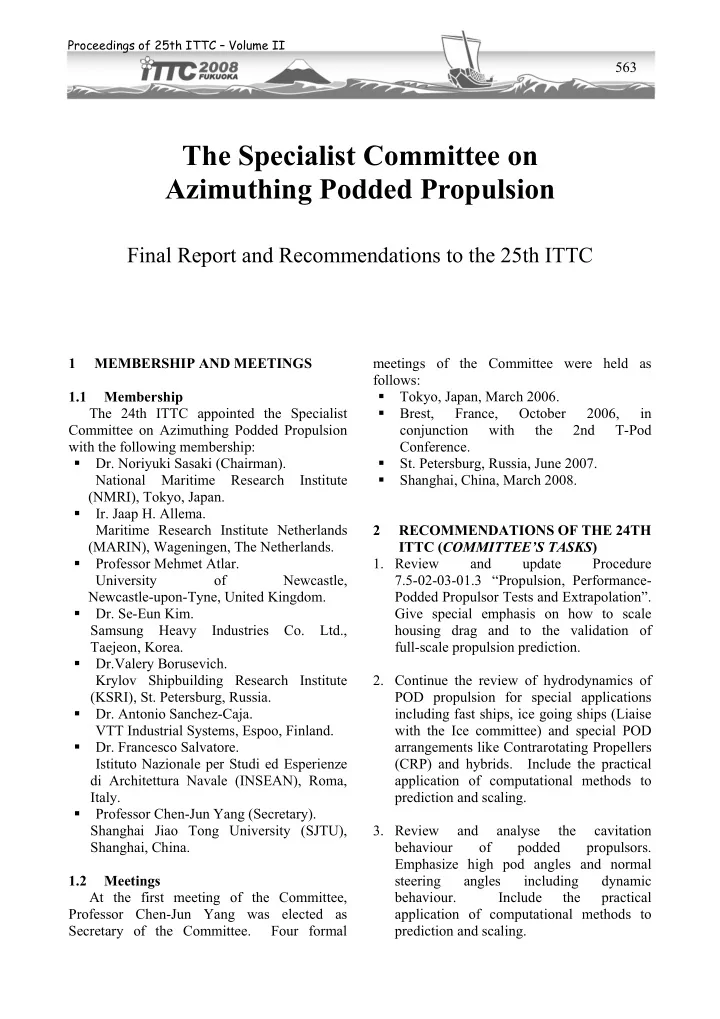

Proceedings of 25th ITTC – Volume II 563 The Specialist Committee on Azimuthing Podded Propulsion Final Report and Recommendations to the 25th ITTC 1 MEMBERSHIP AND MEETINGS meetings of the Committee were held as follows: � Tokyo, Japan, March 2006. 1.1 Membership The 24th ITTC appointed the Specialist � Brest, France, October 2006, in Committee on Azimuthing Podded Propulsion conjunction with the 2nd T-Pod with the following membership: Conference. � Dr. Noriyuki Sasaki (Chairman). � St. Petersburg, Russia, June 2007. � Shanghai, China, March 2008. National Maritime Research Institute (NMRI), Tokyo, Japan. � Ir. Jaap H. Allema. Maritime Research Institute Netherlands 2 RECOMMENDATIONS OF THE 24TH (MARIN), Wageningen, The Netherlands. ITTC ( COMMITTEE’S TASKS ) � Professor Mehmet Atlar. 1. Review and update Procedure University of Newcastle, 7.5-02-03-01.3 “Propulsion, Performance- Newcastle-upon-Tyne, United Kingdom. Podded Propulsor Tests and Extrapolation”. � Dr. Se-Eun Kim. Give special emphasis on how to scale Samsung Heavy Industries Co. Ltd., housing drag and to the validation of Taejeon, Korea. full-scale propulsion prediction. � Dr.Valery Borusevich. Krylov Shipbuilding Research Institute 2. Continue the review of hydrodynamics of (KSRI), St. Petersburg, Russia. POD propulsion for special applications � Dr. Antonio Sanchez-Caja. including fast ships, ice going ships (Liaise VTT Industrial Systems, Espoo, Finland. with the Ice committee) and special POD � Dr. Francesco Salvatore. arrangements like Contrarotating Propellers Istituto Nazionale per Studi ed Esperienze (CRP) and hybrids. Include the practical di Architettura Navale (INSEAN), Roma, application of computational methods to Italy. prediction and scaling. � Professor Chen-Jun Yang (Secretary). Shanghai Jiao Tong University (SJTU), 3. Review and analyse the cavitation Shanghai, China. behaviour of podded propulsors. Emphasize high pod angles and normal 1.2 Meetings steering angles including dynamic At the first meeting of the Committee, behaviour. Include the practical Professor Chen-Jun Yang was elected as application of computational methods to Secretary of the Committee. Four formal prediction and scaling.
Specialist Committee on Azimuthing Podded Propulsion 564 From herein, the report content is as 3 INTRODUCTION follows: � Section 4: State-of-the-art review � 3.1 General Remarks Section 5: Podded propulsor tests and It is very obvious that the technology of extrapolations ( Task 1 ) Podded Propulsion tests have much progressed � Section 6: Guidelines on extrapolation to in the field of not only simple application as full-scale ( Task 1 ) propulsion system for conventional vessel such � Section 7: Questionnaire � as cruise ships but also complex application Section 8: Dynamic behaviour at high pod such as double action ships (DAS) and hybrid angles ( Task 3 ) contra rotating podded propulsion installed on � Section 9: Special applications for podded high speed RO/RO vessel (HAMANASU). propulsion ( Task 2 ) Another remarkable change is the increment of � Section 10: Technical conclusions � application of podded propulsion system of Section 11: References smaller size. � Appendix A: Improved interim procedures Fast Ship Application for Pod Drives (7.5-02-03-01.3) for podded propulsor tests (FASTPOD) was a collaborative Research and and extrapolation & Technical Development (RTD) project participated by 17 partners from 7 European countries. The project ran three years 4 STATE-OF-THE-ART between 2002 and 2005 and was sponsored by the European Commission through the Fifth 4.1 Introduction Framework Program (FP5). The principal The following is an update on some objective of the FASTPOD project was to high-profile pod related R&D activities, explore a new design technology to exploit the interesting landmark applications of pod driven benefit that can be offered when using electric ships, dedicated international conferences and pod drives on commercial large and fast ships other related events to reflect on the state-of-the-art on pod propulsion since the 24 th (35-40kts) in an efficient, safe and environmental friendly manner. ITTC reporting. SES (Super Eco-Ship) projects in Japan has been promoting many novel coastal ships 4.2 Research and development activities driven by podded propulsion system. The In Europe, under the EC Framework projects started from 2001 and can be divided Programme (FP5), a 3 year RTD project into two projects. SES phase1 is a project for FASTPOD (Fast Ship Applications of for Pod developing new technology concerned with Drives) participated by 17 EU partners from 7 electric propulsion system including podded EU countries was completed in early 2006. propulsor and the research programme was The principle objective of the FASTPOD finalised in 2005 and the project has established project was to explore a new design technology economical supporting system of new buildings to exploit the benefits that can be offered when of novel ships with electric driven propulsor. using electric pod drives on commercial large The second project is called SES phase 2 and and fast ships (35-40 knots) in an efficient, safe the project aims to develop combined system of and environmentally friendly manner. The marine gas turbine and pure CRP podded project explored the potential applications of propulsor. The first vessel of SES phase 1 conventional pod motor technology on a “Shin-ei Maru” was delivered 2007 and the conventional ropax (38 knots) and container first vessel of SES phase 2 “Shige Maru”was ship (35 knots) as well as a trimaran cargo 2008. vessel (40 knots) using numerical and experimental methods. An overall summary and conclusions of this project is given by 3.2 Report layout
Recommend
More recommend